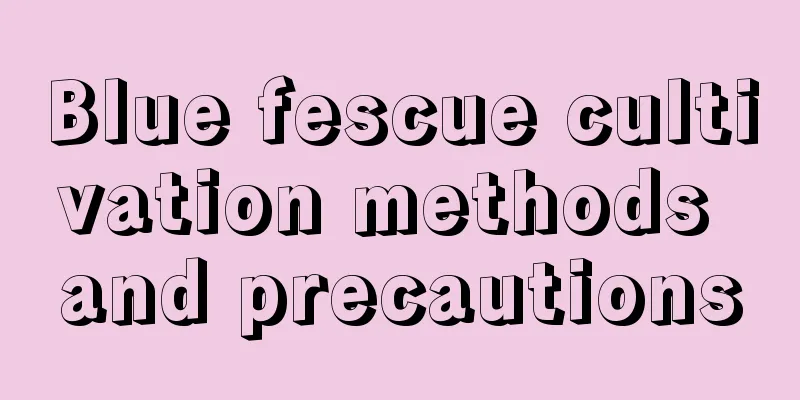Blue fescue cultivation methods and precautions

1. Maintenance methods1. Temperature: The suitable maintenance temperature is between 10 and 30 degrees. Generally, after September, the temperature will gradually decrease. When the temperature is below ten degrees, its growth will be very slow, and then it will enter a dormant period. 2. Watering: Good water management is needed in the first year of planting. The plant should not be kept in a state of water shortage. It should be watered appropriately to allow the roots to fully absorb water. In the first year, special watering is generally not required. Only in extremely dry conditions, watering is required, generally once a month. Keeping the plant properly dry in summer can turn the leaves blue, which can enhance its ornamental value. 3. Fertilization: It is tolerant to barrenness and cannot be over-fertilized. If over-fertilized, the plant will die due to loss of characteristics. Generally, it is sufficient to fertilize once a year, and use light fertilizer. 4. Light: It needs a lot of sunlight to grow. The more light it gets, the brighter its color will be. Therefore, during the maintenance process, it is necessary to give it plenty of light, preferably all-day sunlight. 2. Breeding techniques1. Reproduction: It can be propagated by sowing. The breeding time is in spring and autumn every year, because the temperature is relatively stable at this time, which is suitable for its growth. First, you need to prepare the seeds and soil. The seeds need to be soaked in fungicide for half an hour in order to enhance resistance. Then sprinkle the seeds into the soil and place them in a cool place for maintenance. It will germinate in about half a month. 2. Pruning: When the seedlings just grow out, the top needs to be cut off to promote the growth of side buds. 3. Problem Diagnosis1. Pests: Red spider mites reproduce very quickly and are very light. They like to suck the sap of blue fescue. Once found, they should be sprayed with 1.8% cypermethrin emulsifiable concentrate. 2. Diseases: Fusarium can infect most green plants, and blue fescue is no exception. Fusarium can cause the plants to rot and damage the plant's conductive tissues, making it impossible for the plant to absorb nutrients. When this happens, you need to use Amicida solution to irrigate the roots. Generally, three consecutive root irrigations can solve the problem. IV. Other issues1. Toxicity: It is non-toxic, but the juice can easily cause allergies in people, so every time you touch the juice of the plant, you must wash it as soon as possible. 2. Edibility: It is an ornamental plant and cannot be eaten. |
<<: Bitter melon cultivation methods and precautions
>>: Cultivation methods and precautions of Ligustrum lucidum
Recommend
What is the reason for the yellow spots on grape leaves? How to treat yellow leaves
1. Reasons for yellow spots on leaves 1. Unsuitab...
What should I do if Xiuyan's succulent plants grow too tall?
What does Xiuyan's fleshy growth look like? W...
The growing environment and local conditions of coconut trees
Coconut Tree Growth Environment and Conditions Th...
Recommended flowers for expressing love on Christmas Eve and Christmas
1. Confession of first love 1. Lilac If it is you...
How to care for succulent Buddha beads in summer
How to care for succulent Buddha beads in summer?...
How to repot purple-leaf plum
Preparation for repotting purple-leaf plum When c...
Diseases and prevention methods of hibiscus chandelier
Diseases of Chandelure Hibiscus: Leaf Spot sympto...
What trees are suitable for planting in sandy land? What trees are better for planting in sandy land?
The trees suitable for planting in sandy land inc...
What to do if the branches of bougainvillea are too long
What are the dangers of branches growing too long...
The efficacy and function of iris, is iris poisonous?
1. Efficacy and Function 1. Promote blood circula...
How to save the seeds of the girl fruit
How to get the seeds of girl fruit The girl fruit...
If you grow camellia like this in autumn, the branches will be filled with bright red flowers!
Beginners buy seedlings like this, and gradually ...
Can chrysanthemums be watered with beer? The correct way to water with beer
Can chrysanthemums be watered with beer? Beer can...
How many days after planting aloe vera?
1. Watering a few days after planting You cannot ...
The combination of strength and softness, the flower fairy - rose flower
Prince's Back Garden Once upon a time, there ...









